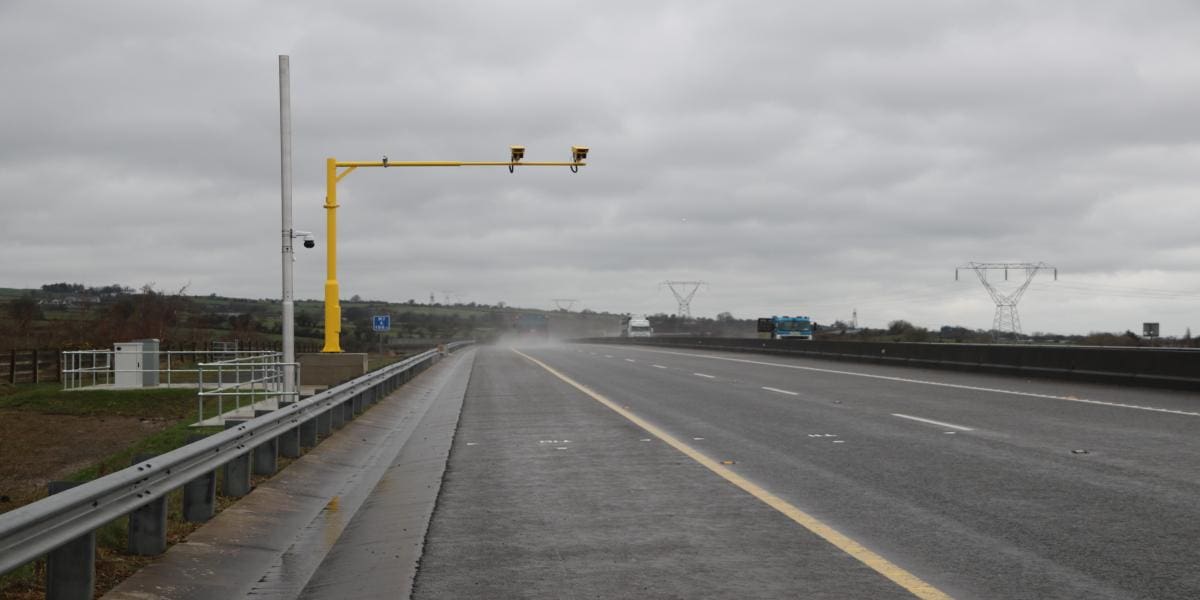The Automobile Association welcomes the introduction of Average Speed cameras across Ireland, with the first being rolled out on the M7 between Junction 26 (Nenagh West) and Junction 27 (Birdhill) in both directions following on from a more than year-long trial of the system.
This is the first stretch of motorway in Ireland to use so-called Average Speed Cameras, and this stretch of road has been trialling this system for a time without prosecutions. But this changed from Monday 25th April.
The trial was announced in March 2021, but there have been delays. The reasons quoted for the delays were the need to calibrate and provide certification for the accuracy of the system.
Gardai have said that prior to the installation of the Motorway Average Speed Safety System, compliance with the 120km/h motorway limit was below 70% – but during the pilot scheme, this has risen but remains below 90%.
Transport Infrastructure Ireland (TII) said it had analysed speed data on the M7 corridor since 2017 and identified speeding as a significant issue, with some 40% of drivers exceeding the 120km/h speed limit on certain sections.
Gardaí point out that speeding is typical of driver behaviour on low-traffic volume sections of the motorway network throughout the country. While there are obvious dangers to this, this is also continuing in adverse weather conditions.
What are Average Speed Cameras?
Average speed cameras work by recording your speed at two different points. They don’t capture your speed in a single flash. Instead, they’ll monitor your speed over a length of road.
This is so people don’t slow down just before they see a camera and then speed up again afterwards. They help to keep the traffic flowing steadily instead of stopping and starting.
A UK Study from 2016 showed a 36% reduction in the rate of fatal and serious collisions post-installation. This isn’t the first in the state. We have had Average Speed Cameras in Dublin’s Port Tunnel since 2017.
Do average speed cameras allow 10 percent?
Data is collected though it depends on the operators. Prior to their introduction, 58% of drivers using the Dublin Port Tunnel exceeded the 80 km/h speed limit, and 20% exceeded this limit by more than 10 km/h. Following the introduction of average speed cameras, the percentage of drivers exceeding the limit by more than 10 km/h has fallen to 0.15%.
How do Average Speed Cameras Work?
Automatic Number Plate Recognition (ANPR) technology is used to ‘read’ the number plate of every vehicle which passes its field of view and creates a time, date, and location file for that vehicle. If a vehicle reaches the next camera too quickly, the enforcement server will highlight that a violation has occurred. These violations can then be exported to a ticketing back-office system for processing.
Average speed cameras are more difficult to trick, but they are seen as also an effective tool for reducing journey times by limiting the disruption to traffic flow that spot speed, traffic lights or speed bumps can cause.
The implementation of average speed solutions has shown that travel times decrease through the enforcement zone due to more disciplined traffic flows. The side-effect of steady traffic flow is that it will help reduce the amount of fuel burned and, as such, decrease particulate matter and noise pollution.
This system is being implemented by An Garda Síochána initially. Speaking to AA Ireland, TII told us they have no details yet about other prospective sites for this type of camera.
Will I be Fined if I’m Caught Speeding by Average Speed Cameras?
Yes. If caught using speeding, using average speed cameras or any speed camera. You will be fined up to €160 and receive three penalty points.










